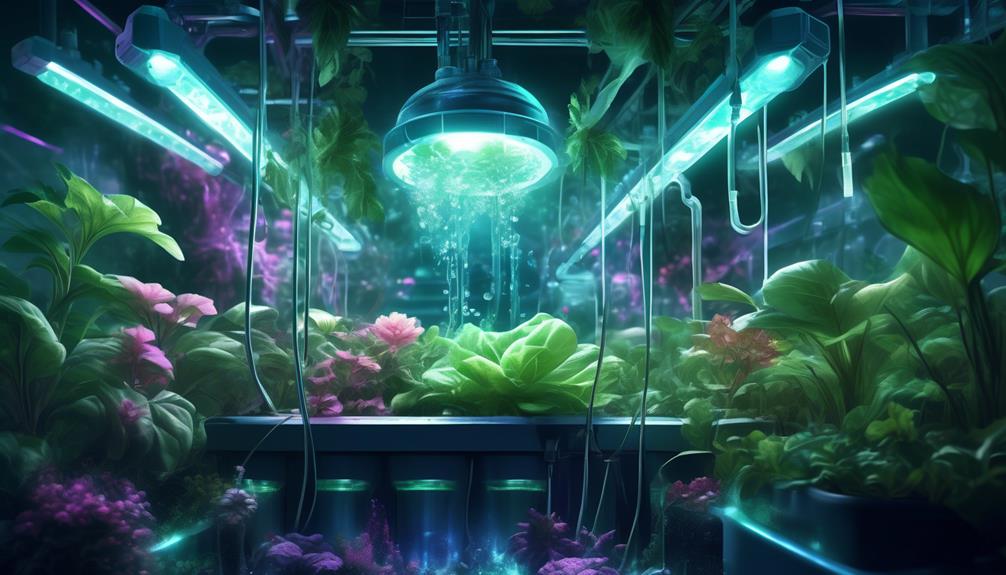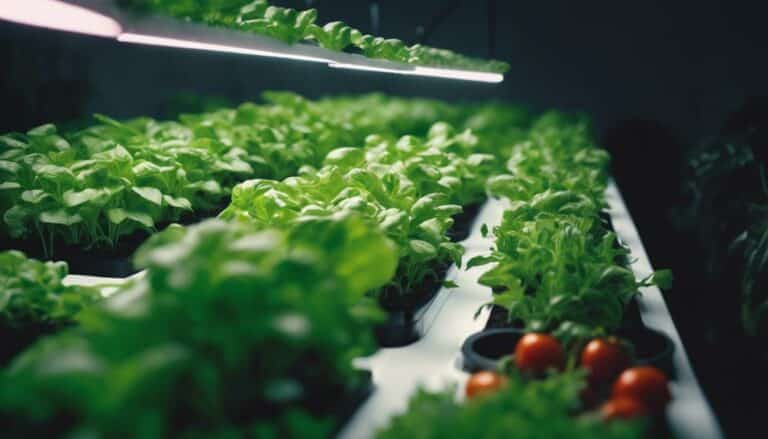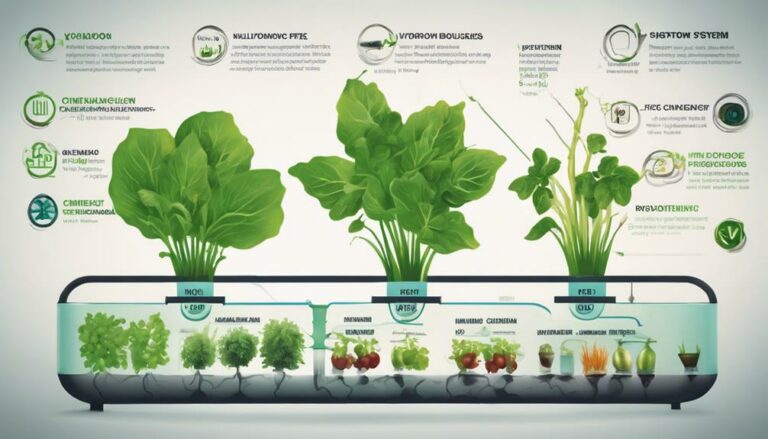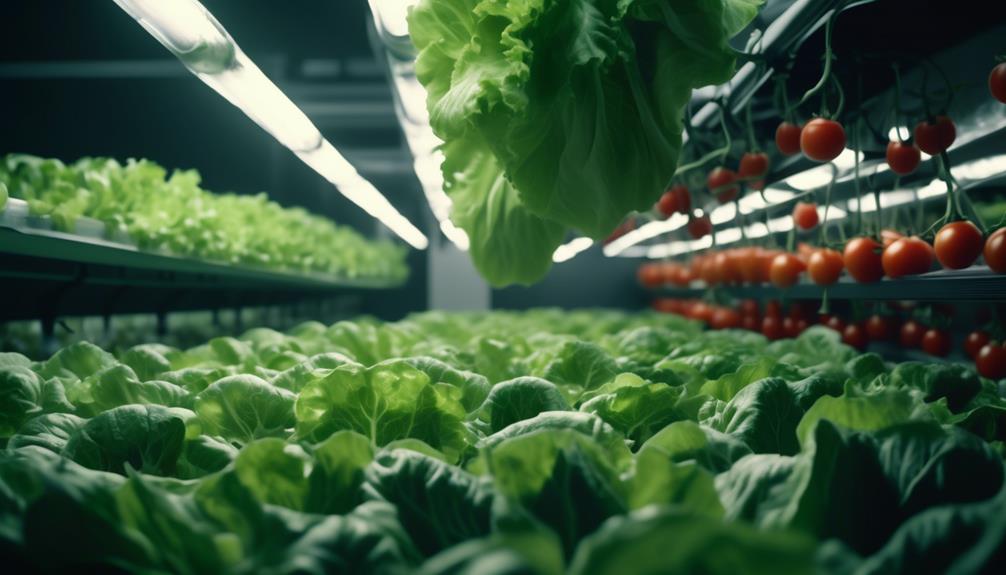In the realm of hydroponic cultivation, the imperative of sustaining optimal oxygen levels within the nutrient solution cannot be overstated. As a cornerstone of a plant’s metabolic processes, dissolved oxygen in hydroponic water facilitates not only aerobic respiration at the root level but also significantly influences nutrient uptake efficiency and the suppression of anaerobic pathogens.
Table of Contents
Precision in maintaining dissolved oxygen concentrations between 7-12 ppm is a testament to a system’s vitality; yet, achieving this requires a nuanced understanding of the interplay between water temperature, aeration methods, and system dynamics. While the implementation of various aeration techniques and equipment is commonly known, the analytical assessment of their effectiveness in different hydroponic setups poses a complex challenge.
It behooves the discerning horticulturist to consider the myriad factors that contribute to this delicate balance, where even minor deviations can have profound implications on plant health and yield. Thus, the question remains: how can one adeptly navigate the intricacies of oxygen level optimization in hydroponic systems to foster an environment where plants not only survive but thrive?
Key Takeaways
- Dissolved oxygen is crucial for facilitating aerobic respiration and nutrient uptake efficiency in hydroponic systems.
- Regular measurement and monitoring of oxygen levels is essential to track patterns and make adjustments to aeration tactics.
- Factors such as temperature, aeration techniques, flow rate, and water circulation strategies can affect oxygenation in hydroponic systems.
- Proper water temperature management, ideally within the range of 65-75°F (18-24°C), is necessary to maintain stable dissolved oxygen levels and ensure optimal root respiration.
Understanding Dissolved Oxygen
Dissolved oxygen plays a pivotal role in hydroponic systems, serving as a fundamental element for plant respiration and root health. As an invisible yet critical component, maintaining adequate oxygen levels ensures that plants can perform metabolic processes efficiently. In hydroponic environments, where soil is not used, dissolved oxygen becomes even more vital for active water uptake and nutrient absorption within the root zone.
Oxygen insufficiency can be detrimental, leading to wilting and suboptimal growth, as roots may suffocate, impairing their function and reducing the vigor of the entire plant. Measuring dissolved oxygen in parts per million (ppm) allows for precise management, ensuring that oxygen supply meets the demands of both plants and the aerobic microbes that thrive in organic hydroponic systems.
Innovation in hydroponic technology increasingly emphasizes the importance of fine-tuning oxygen levels to optimize plant performance. Systems are being designed to circulate and aerate water meticulously, thereby enhancing oxygen availability. The introduction of advanced sensors and monitoring equipment offers growers the capability to maintain ideal oxygen concentrations consistently, safeguarding the health and productivity of hydroponic crops.
Measuring Oxygen Levels
To ensure the vitality of hydroponic systems, growers must regularly employ a dissolved oxygen meter for precise monitoring of oxygen levels within the water. Measuring oxygen levels accurately is crucial for assessing the availability of oxygen in the root zone, which directly impacts plant growth and health. High oxygen levels are typically indicative of a well-aerated and dynamic root environment, whereas low oxygen conditions can lead to root diseases and reduced nutrient uptake.
Employing a methodical approach to monitoring DO levels allows for informed decisions on when to add oxygen or adjust aeration strategies. Here are key considerations for effective measurement:
- Select an appropriate DO meter: Invest in a reliable, waterproof, and portable meter for consistent readings.
- Record measurements regularly: Keep a log to track DO levels over time and identify patterns.
- Measure at various points: This ensures even distribution of oxygen throughout the system.
- Adjust aeration tactics: Use the data to fine-tune methods for maintaining high dissolved oxygen levels.
Analyzing these parameters permits a proactive regimen that sustains an optimal root system, fostering robust plant growth by ensuring adequate oxygen in the root zone.
Factors Affecting Oxygenation

Having outlined the importance of monitoring dissolved oxygen levels, it is imperative to examine the various factors that influence oxygenation in hydroponic systems. Dissolved oxygen is crucial for sustaining the metabolic rate of plant roots, ensuring efficient nutrient uptake, and preventing anaerobic conditions that can foster harmful pathogens.
One primary determinant of dissolved oxygen content is the temperature of the nutrient solution. Warmer water holds less oxygen, necessitating careful temperature regulation to maintain the recommended 7-12 ppm.
Furthermore, the implementation of air pumps and aeration techniques directly influences oxygen saturation. The introduction of microbubbles through air stones or diffusers enhances the oxygenation process, facilitating a more homogenous distribution of dissolved oxygen within the nutrient solution.
The flow rate of the water also plays a critical role in oxygenation. Systems like the nutrient film technique rely on a thin film of nutrient solution flowing over the roots, which not only provides nutrients but also ensures that roots are continually exposed to oxygen-rich environments.
To optimize oxygen levels, hydroponic systems must integrate efficient water circulation strategies. This ensures that dissolved oxygen is replenished and available throughout the root zone, averting the possibility of hypoxic stress that can impair plant growth and vigor.
Aeration Techniques Explained
Aeration techniques in hydroponic systems are pivotal for enhancing the solubility of oxygen, thereby ensuring the vitality of plant root systems and overall crop productivity. Effective aeration combats the challenges of oxygen management by increasing the dissolved oxygen content, which is essential for nutrient uptake and preventing root diseases.
- Air Stones: These are commonly used in hydroponic setups, particularly in deep water culture (DWC) systems. Air stones diffuse air into the water, creating fine bubbles for improved oxygen dissolution.
- Venturi Attachments: These devices are installed in the water circulation system and utilize a pressure differential to draw in air, which is then mixed with the nutrient solution, increasing oxygen levels.
- High Flow Rates: In NFT (Nutrient Film Technique) systems, maintaining high flow rates of the nutrient solution ensures a constant supply of oxygen to the roots and prevents stagnation.
- Supplemental Oxygen Systems: For larger or more demanding hydroponic operations, direct oxygen injection systems can be used to achieve precise control over dissolved oxygen levels.
Innovative aeration techniques must be carefully selected and adjusted to match the specific requirements of each hydroponic system, taking into account factors such as plant type, growth stage, and system size, to maintain oxygen levels within the recommended range of 7-12 ppm for optimal plant health and yield.
Water Temperature Management
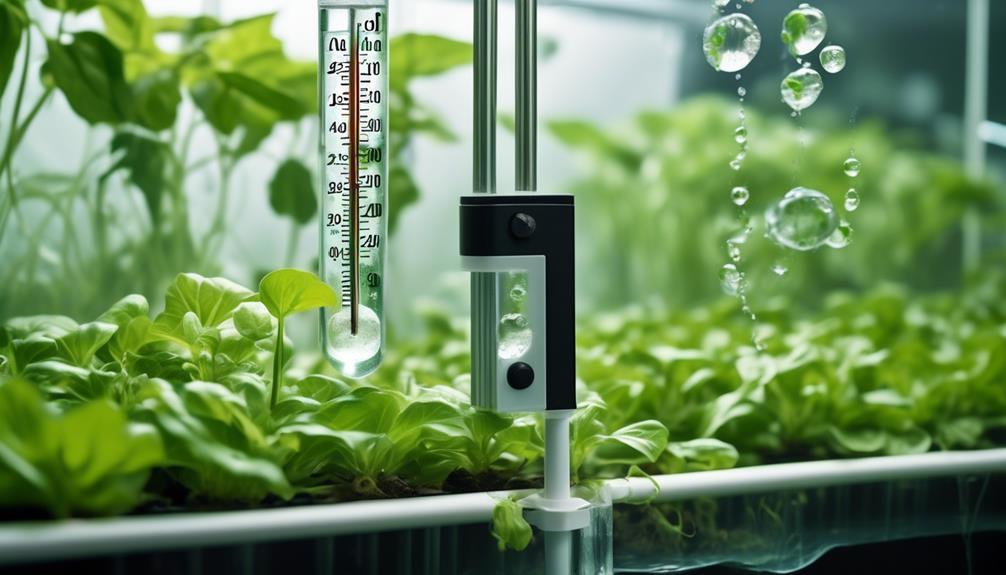
Water temperature plays a pivotal role in the solubility of oxygen in hydroponic systems. Higher temperatures inversely affect the oxygen levels available to plant roots. Identifying and maintaining an ideal water temperature range is critical to optimizing the growth conditions within a hydroponic environment.
Continuous monitoring and precise regulation of water temperature are necessary to ensure a stable and oxygen-rich habitat for hydroponic plants. This can be achieved through the use of heaters or chillers.
Ideal Water Temperature Range
Optimal plant growth and nutrient assimilation in hydroponic systems are heavily influenced by maintaining water temperatures within the range of 65-75°F (18-24°C), which is essential for ensuring maximum oxygen solubility. The intricacies of water temperature management pivot on the understanding that:
- Elevated root temperatures can compromise nutrient uptake and overall plant health.
- A stable level of dissolved oxygen within the hydroponic solution is critical for root respiration.
- Techniques such as nutrient film technique rely on consistent solution temperatures to prevent thermal stress.
- Implementing water heaters or chillers can mitigate risks posed by temperature fluctuations.
These considerations underscore the necessity for precise control over the thermal environment to maintain an optimal hydroponic ecosystem.
Temperature’s Effect on Oxygen
Understanding the thermodynamics of liquid environments reveals that as water temperature increases, the capacity for dissolved oxygen correspondingly decreases, presenting a critical challenge in hydroponic agriculture. In the delicate ecosystem where plants are grown, this temperature’s effect on oxygen can significantly influence root respiration and nutrient absorption.
Optimal oxygen levels, ranging from 6 to 12 ppm, are pivotal for not only the plants but also for sustaining beneficial microbes that support plant health. However, warmer water holds less oxygen, potentially leading to root suffocation.
Consequently, precision in water temperature management becomes paramount. Advanced irrigation systems must integrate water heaters or chillers to moderate temperature, thereby ensuring a stable environment for maximum oxygen solubility and overall plant vitality.
Regulating Temperature Consistently
Recognizing the inverse relationship between water temperature and oxygen solubility underscores the necessity for meticulous temperature regulation in hydroponic systems. As temperature rises, oxygen’s ability to remain dissolved in water diminishes, necessitating a carefully designed approach to maintain the balance. Optimal levels of dissolved oxygen are critical for plant health, as they ensure efficient nutrient uptake and robust growth.
- Monitor water temperature regularly to detect and address fluctuations promptly.
- Incorporate water heaters or chillers to keep temperatures within the ideal range.
- Insulate water reservoirs to prevent external temperature variations from affecting the system.
- Ensure air pumps and stones are high enough in quality to compensate for less oxygen solubility at higher water temperatures.
Root Zone Oxygen Practices
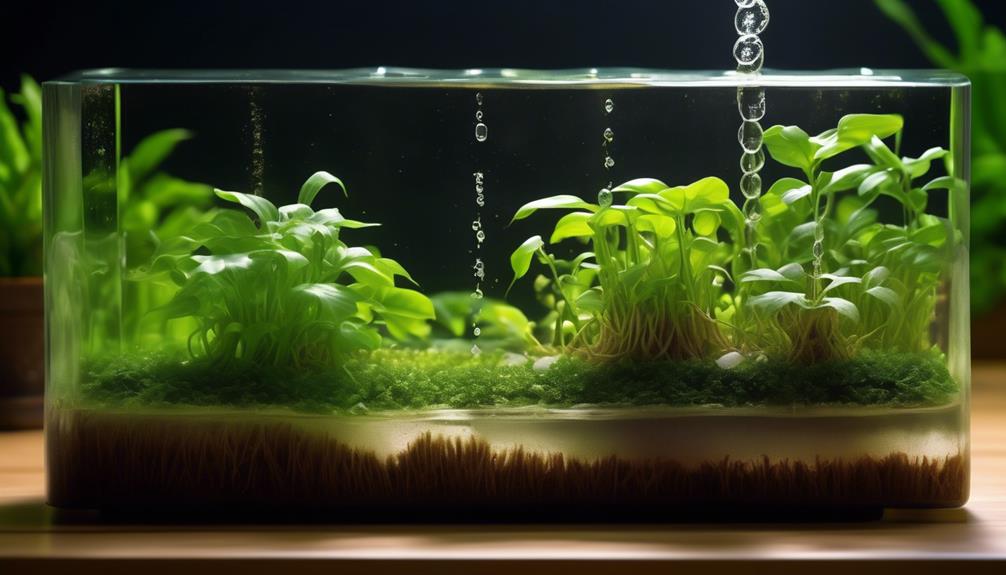
To ensure the vigorous growth and health of hydroponic crops, maintaining sufficient oxygen levels within the root zone is imperative. Root zone oxygen practices involve innovative strategies to deliver much oxygen as needed without overwhelming the system, which could cause less beneficial outcomes. The solution needs to be tailored to each hydroponic setup, ensuring that oxygen present is at an optimal level to prevent root hypoxia, which can lead to wilting and poor plant productivity.
| Method | Benefit |
|---|---|
| Air pumps | Constant oxygen supply |
| Water pumps with Venturi attachments | Enhanced oxygen dissolution |
| Regular monitoring of oxygen levels | Prevention of oxygen depletion |
| Adjustments based on plant demand | Tailored oxygen supply |
| Use of oxygenating compounds | Immediate increase in dissolved oxygen |
The recommended oxygen levels of 7-12 ppm indicate the precision required in root zone oxygen practices. Low oxygen levels can stress plants, resulting in less efficient nutrient uptake and stunted growth. Therefore, the incorporation of these practices in the management of hydroponic water systems is not just an innovative approach but a fundamental aspect of successful hydroponic farming.
Oxygen Boosting Additives
Oxygen boosting additives, such as hydrogen peroxide and potassium peroxide, offer a practical method to augment the dissolved oxygen levels in hydroponic solutions, thereby supporting robust root development and preventing oxygen deficits that can impede plant growth.
Kuack, a freelance technical writer in Fort Worth, emphasizes the innovative potential of these supplements. He notes that many hydroponic enthusiasts and professional growers seek new ways to optimize their systems, and oxygen boosting additives are at the forefront of this endeavor. The analytical precision needed to apply these substances effectively requires attention to detail and an understanding of the system’s dynamics.
Consider the following when incorporating oxygen boosting additives into a hydroponic setup:
- Dosage accuracy: Ensuring the correct amount is added to avoid toxicity or inefficacy.
- Monitoring: Keeping track of oxygen levels to prevent oversaturation.
- Root health: Observing root development as an indicator of adequate oxygenation.
- System compatibility: Verifying that additives do not react adversely with other system components.
Said growers must be logged in to post a comment, reflecting the interactive nature of the hydroponic community where experience and knowledge are shared. It’s a space where precision and innovation drive success, and where the insights of a technical writer can illuminate the path to healthier plants and more efficient systems.
How Can Proper Oxygen Levels in Hydroponic Water Benefit Vertical Hydroponic Systems?
Proper oxygen levels in hydroponic water are crucial for the success of vertical hydroponic systems. Without adequate oxygen, roots can become waterlogged and drown, leading to crop failure. To ensure optimal oxygenation, follow a stepbystep vertical hydroponic tutorial for setting up and maintaining your system.
Monitoring and Adjusting Levels
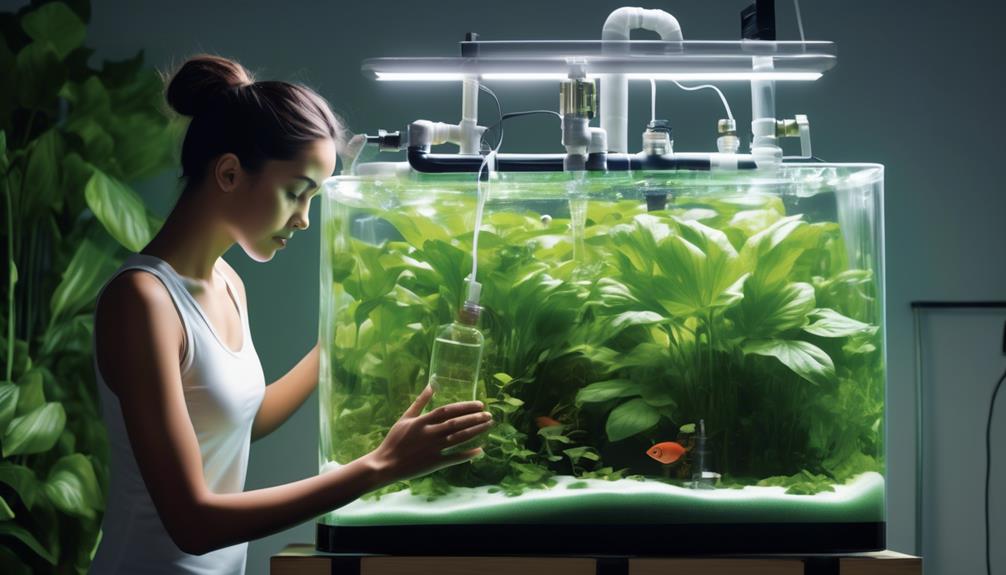
Ensuring optimal plant growth in hydroponic systems necessitates regular measurement and adjustment of dissolved oxygen levels within the 7-12 ppm range. A technical writer in Fort Worth may intricately describe the use of precision oxygen meters and responsive sensors, which are indispensable for monitoring these levels. Such devices facilitate real-time adjustments, ensuring the nutrient solution remains conducive for root health and plant vitality.
In advanced hydroponic setups, the rate of oxygenation is often increased by integrating air pumps that deliver a specific volume of air per minute, as well as air stones or water pumps equipped with Venturi attachments. These modifications are essential for enhancing the dissolved oxygen content, particularly in systems like nutrient film technique (NFT), where oxygen delivery is paramount.
Innovative growers are also turning to alternative oxygenation methods, including cascading water techniques and oxygen-generating systems. Oxygen injectors, for instance, can be highly effective in supersaturating the nutrient solution with oxygen. For those interested in such advanced technologies, shipping to the Continental U.S. is typically available—see Terms and Conditions for details.
Regularly adapting these aeration and circulation strategies is critical for maintaining the delicate balance of dissolved oxygen required for hydroponic success. This constant vigilance supports robust root development, efficient nutrient uptake, and ultimately, vigorous plant growth.
Frequently Asked Questions
How Do You Maintain Oxygen in Hydroponics?
To enhance hydroponic oxygenation, deploy aeration methods such as air pumps or water movement techniques. Prioritize system design that supports root health, regulates water temperature, and maximizes nutrient uptake, mitigating plant stress.
What Is Good Dissolved Oxygen Level for Hydroponics?
Optimal dissolved oxygen levels for hydroponics facilitate root health and nutrient uptake, minimizing plant stress. Advanced oxygen monitoring and aeration methods ensure a balance, with 7-12 ppm ideal for robust growth rates.
How Do You Keep a Good Level of Dissolved Oxygen in Water?
To ensure adequate dissolved oxygen, employ oxygenating techniques such as air pumps, diffusion stones, and aeration devices to enhance circulation methods, regulate water temperature, and thus optimize nutrient uptake in hydroponic systems.
Can You Over Oxygenate Water in Hydroponics?
Like a diver ascending too quickly, plants in hydroponics can suffer from oxygen toxicity risks. Proper aeration techniques and oxygen monitoring methods must account for plant species sensitivity and the catalytic role of water temperature.
Conclusion
In conclusion, despite the tranquil image of water as a serene and life-sustaining force, its stillness often belies a potential silent killer for hydroponic systems: hypoxia.
Vigilance in maintaining dissolved oxygen levels is not merely beneficial but essential, as the roots’ unseen struggle for breath underpins the verdant splendor above.
Thus, the aqua pura must be enlivened with unseen bubbles of life to sustain the verdurous growth it so deceptively promises.

